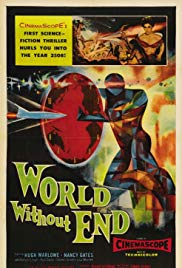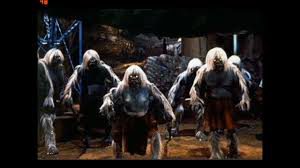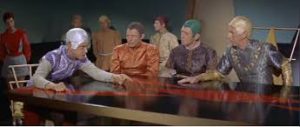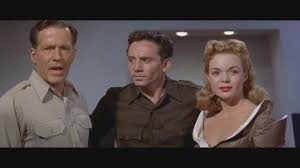World Without End *** (1956, Hugh Marlowe, Nancy Gates, Rod Taylor) – Classic Movie Review 3983

‘THE 26TH CENTURY! Sub-Human Monsters… Mammoth Tiger Spiders… Mole-Tunnel Cities… Futurific Women… in the Screen’s Mighty Science-Shocker!’
Writer-director Edward Bernds’s daft but enjoyable 1956 sci-fi movie World Without End tells the tale of a space mission of four astronauts returning from mankind’s first mission to Mars. They are caught in a time warp and unwittingly travel forward in time, crashing on to a post-apocalyptic 26th century Earth inhabited by fearsome monsters and mutant troglodyte cavemen Earthlings.
The film is set in March 1957 and in 2508, when things have changed a bit. ‘The surface of the Earth was meant for man,’ says the hero John Borden. ‘He wasn’t meant to live in a hole in the ground.’
But for fearsome monsters read rubbery giant spiders, and for troglodytes read love-struck women in hip-hugging lycra. Hugh Marlowe, Nancy Gates and Rod Taylor star as John Borden, Garnet and Herbert Ellis. They must battle to save humanity and build a new world if they can.
The intriguing plot (predating the similarly themed Planet of the Apes and accessing the time travel theme of the H G Wells novel The Time Machine), good cast, Bernds’s taut screenplay, brisk action and fast-moving direction lift a standard, cheap-looking Fifties futuristic hokum B-movie of the kind collectors of kitsch have come to love so well.
Also in the cast are Booth Colman, Christopher Dark, Lisa Montell, Nelson Leigh, Everett Glass, Stanley Fraser, Shirley Patterson [Shawn Smith], William Vedder, Paul Brinegar, Herb Vigran, Mickey Simpson and Rankin Mansfield.
World Without End is directed by Edward Bernds, runs 80 minutes, is made by Allied Artists Pictures, is released by Allied Artists Pictures (1956) (US) and Associated British-Pathé (1956) (UK), is written by Edward Bernds (story and screenplay), is shot in Technicolor and CinemaScope widescreen by Ellsworth Fredericks, is produced by Richard V Heermance, is scored by Leith Stevens and is designed by Alberto Vargas.
It is shot at the Iverson Ranch, 1 Iverson Lane, Chatsworth, Los Angeles, between 19 July and August 1955.
Rod Taylor was later the star of George Pal’s 1960 film of The Time Machine.
Reynold Brown illustrated the poster art.
Bernds first sought Sterling Hayden as star but producer Heermance hired Hugh Marlowe, who asked for only a quarter of the other actors’ salaries. Bernds alleged that Marlowe was often lazy and unprepared. Bernds disagreed with Heermance’s budget saving, especially in the economically filmed final scene. Originally the plan was to use stock footage from Flight to Mars (1951).
Allied Artists Pictures gave it a larger budget and longer running time than their usual, plus colour and CinemaScope. They booked it into cinemas under percentage contracts rather than flat rates.
The H G Wells estate sued the producers for plagiarism, citing similarities to Wells’s novel The Time Machine, though time travel is the only hing they have in common.
The title comes from: ‘Glory to the Father and to the Son and to the Holy Spirit; as it was in the beginning is now and ever shall be, world without end. Amen.’
It was released in a double bill with Indestructible Man (1956).
Bernds reused the motorised spiders in Queen of Outer Space (1958) and Valley of the Dragons (1961).
Bernds claims to have invented the word ‘mutate’ in this film.
RIP Nancy Gates, actress in Comanche Station and the Sinatra films Suddenly and Some Came Running, who died at 93 on March 24, 2019.
© Derek Winnert 2016 Classic Movie Review 3983
Check out more reviews on http://derekwinnert.com










